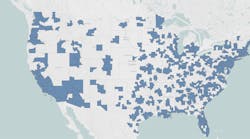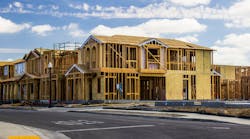Even for electrical distributors, manufacturers and reps who don’t do much work in the residential market, the health of the housing industry is an important leading economic indicator to watch.
When folks are buying houses, it creates demand for countless other industries that sell products for new homes, including furniture stores, home centers, mortgage companies and garden centers. And while the residential market accounts for an estimated 15% to 20% of total electrical sales for electrical distributors overall, it also has a sizeable impact on the commercial construction market, because new homebuyers create demand for new stores, medical buildings, restaurants, movie theaters, and many other service providers, as well as schools and hospitals.
After a strong run over the past few years, the housing market has hit some turbulence. Rising interest rates, concerns over housing prices, and an increase in housing inventory have squeezed consumer demand.
There’s been some noticeable softening in the single-family permit data in some major markets that had previously been very active, including Seattle (-9.6% year-over-year, through Oct. 2018); Fort Collins, CO (-18.6 over that same period); and Myrtle Beach, SC (-10.4%) (see chart linked below). Some perennial hot spots are still sizzling, with the following markets up double-digits: Phoenix, AZ; Austin and Houston, TX; all major markets in Colorado with the exception of Fort Collins; and most major markets in the Sunshine State, including Jacksonville, Orlando, Tampa, and Ft. Myers-Cape Coral.
The softer housing market has also had a direct impact on housing stocks. On the news earlier this week that luxury homebuilder Toll Brothers had seen some softening in home sales in its California market, the SPDR S&P Homebuilders exchange-traded fund XHB dropped 4.5%, with all 35 of its equity components closing lower. Its holdings include large publicly traded homebuilders such as Toll Brothers, PulteGroup, D.R. Horton and Lennar, and building material companies like Owens Corning, A.O. Smith and Trex.
Toll Brothers has had good growth in 2018, but a senior executive’s frank outlook for the future quickly drove down the price of its shares by about -4%. Said Douglas Yearley, Jr., the company’s chairman and CEO, in the press release, “In our fourth quarter, despite a healthy economy, we saw a moderation in demand. Fourth quarter contracts declined -15% in dollars and -13% in units compared to a difficult comp from one year ago.
“In November, we saw the market soften further, which we attribute to the cumulative impact of rising interest rates and the effect on buyer sentiment of well-publicized reports of a housing slowdown. We saw similar consumer behavior beginning in late 2013, when a rapid rise in interest rates temporarily tempered buyer demand before the market regained momentum.
“California has seen the biggest decline. Significant price appreciation over the past few years, fewer foreign buyers in certain communities, and the impact of rising interest rates all contributed to this slowdown.”
Another indicator pointing downward is contract signings for new homes. According to the National Association of Realtors, year-over-year contract signings dropped -6.7% in October, the tenth straight month of annual decreases. Lawrence Yun, NAR chief economist, said in the release that one cause for the decline in housing sales is that the recent rise in mortgage rates have reduced the pool of eligible homebuyers.
He would like to see the Federal Reserve stop raising rates. “The inflationary pressure is all but disappearing,” Yun said in the press release. “Given that condition, there is less of a need to aggressively raise interest rates. Looking at the broader economy and keeping in mind that the housing sector is a great contributor to the economy, it would be wise for the Federal Reserve to slow the raising of rates to see how inflation develops.”
Yun expects existing-home sales this year to decrease -3.1% to 5.34 million, and for the national median existing-home price to increase +4.7%. He expects existing sales to decline 0.4% in 2019 and for home prices to drop roughly -2.5% next year.









